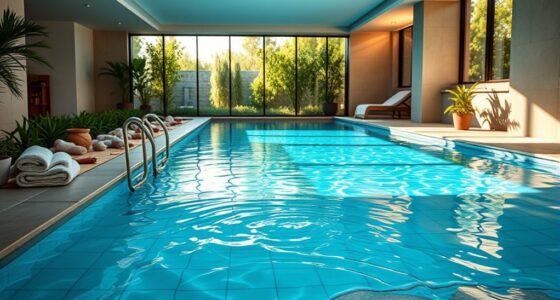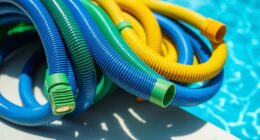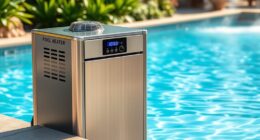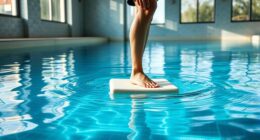Spend 10 minutes each day checking your saltwater pool’s chemical levels, especially pH and salt, and adjust as needed. Inspect your equipment, including the chlorinator, pump, and filters, for proper operation. Clear debris from skimmer baskets and skim the surface to prevent algae. Test your water regularly and brush off algae or dirt. Keeping a consistent routine guarantees your pool stays balanced and clean—continue on to discover how to optimize your maintenance routine even further.
Key Takeaways
- Check and adjust pH levels to stay within 7.4–7.6 for comfort and sanitizer efficiency.
- Inspect and clean the pump, chlorinator, and skimmer basket for proper operation.
- Verify water level is at the skimmer midpoint for optimal circulation.
- Test chemical levels regularly and make quick adjustments as needed.
- Dedicate 10 minutes daily to focused maintenance, including debris removal and equipment inspection.
Daily 10-Minute Saltwater Pool Maintenance Routine
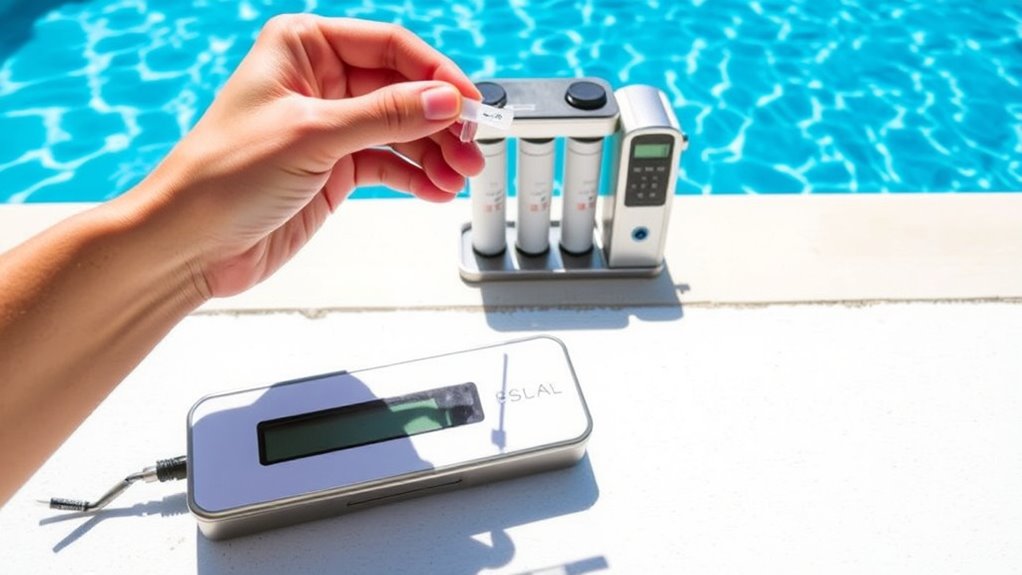
Maintaining a saltwater pool requires some specific care to keep the water clean, clear, and balanced. One of the most effective ways to do this is by dedicating just ten minutes each day to a quick, focused routine. This simple routine helps guarantee your pool’s chemistry stays stable and your equipment functions properly, which are key to avoiding costly repairs and lengthy clean-up sessions later on. The first step is to check your pool’s chemical levels, especially the pH and salt levels. You want to keep the pH between 7.4 and 7.6, as this range ensures comfort for swimmers and maximum sanitizer effectiveness. If the pH is off, use pH increasers or decreasers to correct it. Simultaneously, verify the salt level—your salt generator relies on proper salinity to produce chlorine effectively. If needed, add salt gradually, following manufacturer guidelines, to reach the ideal range.
Next, focus on maintaining your equipment. During this quick check, inspect your saltwater chlorinator, pump, and filtration system to make sure they’re running smoothly. Clean any debris from the skimmer basket and pump strainer, as clogs can hinder circulation and reduce water quality. Run your pump for a few minutes to verify it’s operating quietly and efficiently, and listen for any unusual noises that might indicate a problem. If you notice reduced flow or strange sounds, it’s a sign that your equipment may need maintenance or repairs. Also, look for leaks or corrosion around fittings and connections—small issues can escalate if ignored, so catching them early keeps your system in top shape. Additionally, modern pool equipment increasingly integrates AI-powered diagnostics, which can help identify issues before they become serious.
Another important step is to check the water level. It should be at the midpoint of the skimmer opening, ensuring proper skimming and circulation. Adjust if necessary. While doing this, take a quick glance at your pool’s surface for any floating debris or algae. Removing debris prevents chemical imbalances and keeps the water sparkling. If you see algae or cloudy water, it’s time for a more thorough treatment, but for now, a quick brush or skim will help maintain clarity. Finally, consider testing your water with a reliable test kit or strips to confirm your chemical balance. If something’s out of range, make the necessary adjustments immediately.
Frequently Asked Questions
How Often Should I Replace the Salt in My Pool?
You should replace the salt in your pool when salinity levels drop below the recommended range, usually around 2700-3400 ppm. Regular salt cell maintenance helps monitor these levels, ensuring your system runs efficiently. Typically, you don’t need to replace all the salt often; instead, top off with fresh salt as needed. Keep testing your water regularly to maintain proper salinity and avoid over-replacing salt.
Can I Use Regular Pool Chemicals With Saltwater Systems?
Yes, you can use regular pool chemicals with saltwater systems, but you need to take into account chemical compatibility to avoid damaging your system. Always check if the chemicals are compatible with saltwater pools before use. Additionally, maintain proper salt levels to ensure your system works efficiently. Regularly monitoring and adjusting the salt level helps keep your pool clean and safe, reducing the need for excessive chemical use.
What Signs Indicate My Saltwater System Needs Repair?
Imagine your saltwater system as a vigilant guardian; if it starts making unusual noises or your salt level dips unexpectedly, it’s signaling distress. These signs indicate your system may need repair. You might notice inconsistent water flow, error messages, or a decline in water quality. Addressing these issues promptly guarantees your system continues to protect and purify, keeping your pool inviting and safe.
Is a Saltwater Pool Safe for Children and Pets?
Yes, a saltwater pool is safe for children and pets when you follow proper pool safety and chemical compatibility guidelines. Always supervise kids and pets around the pool, verify the salt levels and pH are balanced, and avoid exposing them to high chlorine levels. Regularly test and maintain your water chemistry, and keep safety equipment nearby. This way, you can enjoy your saltwater pool without worries.
How Do I Troubleshoot Cloudy or Green Water Issues?
To troubleshoot cloudy or green water, start by checking for pool algae and water clarity issues. Brush the pool walls and vacuum debris to remove algae buildup. Test and balance your water’s pH, alkalinity, and chlorine levels, then shock the pool if needed. Run the filter continuously and clean the filter regularly. These steps target algae removal and improve water clarity, helping your pool look crystal clear again.
Conclusion
Stick to this 10-minute routine, and your saltwater pool will stay crystal clear and inviting, just like a sparkling gemstone. Think of it as giving your pool a quick check-up, like a mini spa day for your water. With consistent care, you’ll enjoy invigorating swims without the hassle. So, make this quick routine a daily habit, and your pool will thank you with perfectly balanced water and endless summer fun.


